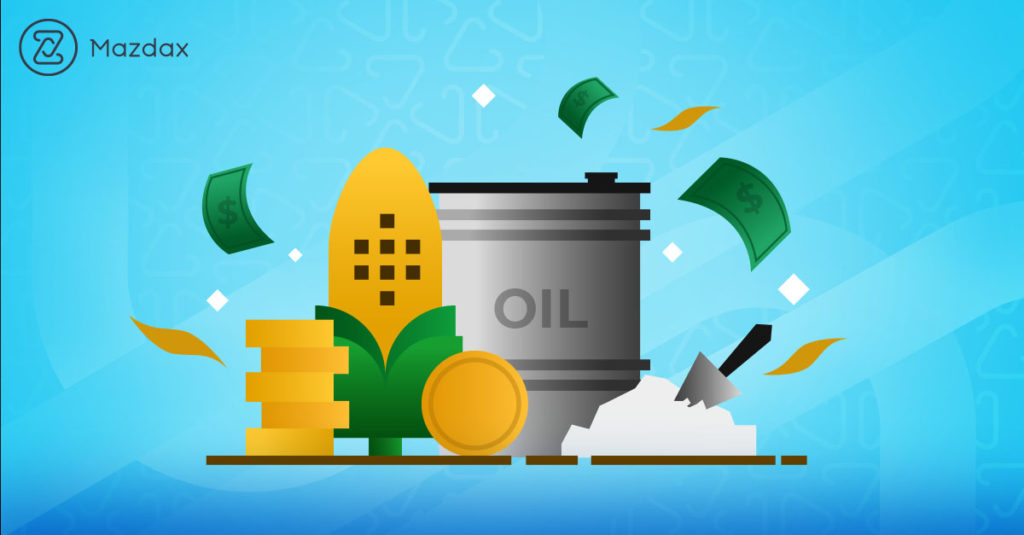Commodities are basic goods that can be substituted for other types of goods and are often used as input components in the production of other products or services. As a result, when a commodity is traded on a stock exchange, it must meet specific standards referred to as “grade”. When it comes to commodities, what are these assets, and what are the benefits of purchasing commodities?
The purpose of this article from the Mazdax Academy is to examine the concept of commodities, their types, benefits, and gain a deeper understanding of this important category of assets.
How is a commodity defined?
Commodities are raw materials used to produce goods. The term commodity may refer to basic raw materials, such as some agricultural products. Commodities are characterized by the fact that they have little difference among themselves. As an example, a barrel of oil, regardless of its producer, is essentially one product. This is also true of a pound of wheat or a ton of ore. There is a fundamental difference between commodities and other products in which the quality factor of commodities is highly influenced by the manufacturer. (For example, Coca-Cola vs. Pepsi).
Some traditional commodity examples include cereals, gold, beef, oil, and natural gas. However, this definition has recently been expanded to include financial products such as currencies and financial indicators.
Commodities can be traded as financial assets on specialized stock exchanges. Additionally, there are derivative markets where you can place contracts on such goods (such as futures and transactions). Some experts believe that each investor should allocate a portion of their assets to commodities. The reason is that they are not correlated with other financial assets and may act as a cover for inflation.
An understanding of a variety of commodities
It has been mentioned in the previous section that the commodity is raw materials or agricultural products that are produced in large quantities. Thus, they are usually traded in bulk and are regarded as one of the main asset classes along with stocks, bonds, and property. Due to the massive nature of commodities, they are not a good investment option for individual investors. The following are some types of commodities:
- Wheat, corn, soybean, or other grain foods
- Cow or other cattle
- cotton
- lumber
- sugar Loaf
- Silver, gold, and other precious metals
- Domestic and foreign currencies
- Coal, oil, and other fossil fuels
As it was mentioned, the commodity is also referred to as a “replaceable” good or same-grade product. This means that they can be exchanged regardless of who produced or extracted them. As an example, if high-quality copper is derived from two mines, one in Colorado and one in Wyoming, they are both interchangeable.
What are the characteristics of commodities?
1. Protection against inflation
When the demand for goods and services increases, the price of those items increases as well. An inflationary environment increases interest rates, thereby increasing the cost of borrowing, and reducing the net income of companies. Shareholders’ profits are also affected by the decline in company income. Consequently, stock prices decrease during times of inflation.
2. Protection against global crises
Conflicts, insurrections, and wars disrupt the supply chain of materials. As a result of such events, the preparation and transportation of raw materials become difficult. Consequently, the supply of raw materials is adversely affected, resulting in an exponential increase in the price of goods. As a result, investing in commodities may help reduce portfolio losses.
3. transparency
Unlike the old systems of the past, commodity trading is now conducted on electronic platforms and is accessible to all market participants. With the use of online trading platforms, fair prices can be determined with a wide range of participation and without the involvement of the buyer and seller. In this system, the price is determined by supply and demand and there is no risk of manipulation.
The factors influencing the price of commodities
Commodity markets are affected by several parameters, from supply and demand for products to the effect of different seasons and weather on production. The following factors affect commodity prices:
- Supply and demand
- US dollar index
- Competition
- Politics
- Macroeconomic factors
- Different seasons
- Weather
لینک کوتاه کپی شد
https://mazdax.ir/academy/en/?p=9212
